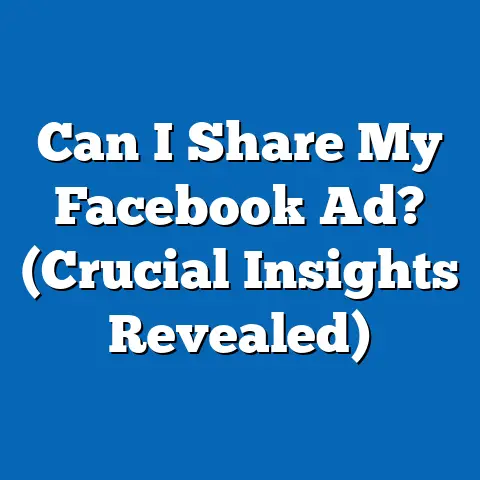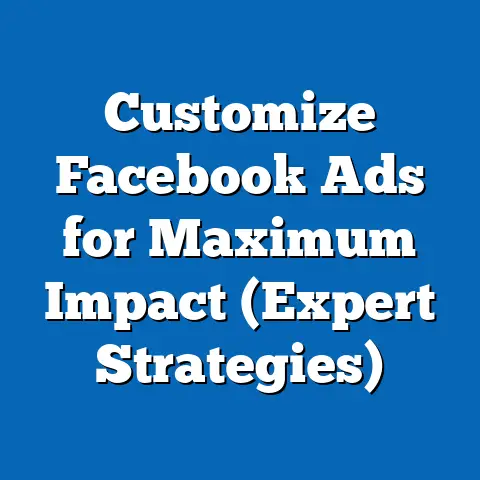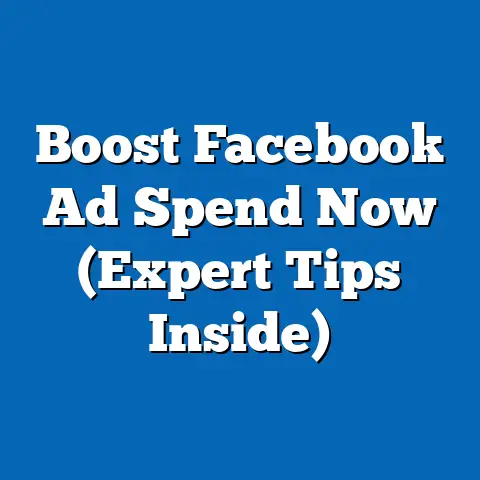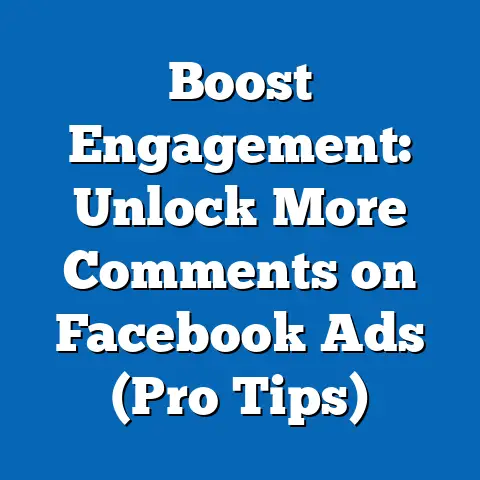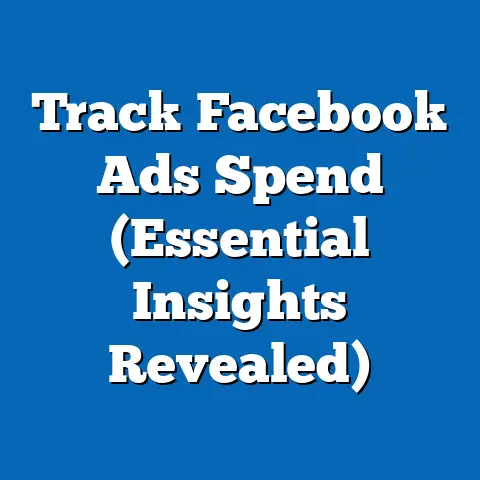Stop Constant Facebook Ads (Ultimate User Guide)
Imagine a typical evening: you’re scrolling through your Facebook feed, catching up on friends’ updates and chuckling at memes, when suddenly, yet another ad for a product you’ve never expressed interest in pops up. This scenario, repeated dozens of times daily, has become a source of frustration for millions of users worldwide. According to a 2022 survey by Statista, 74% of social media users report feeling overwhelmed by the frequency of ads on platforms like Facebook, with 62% actively seeking ways to reduce or eliminate them.
This article dives deep into the pervasive issue of constant Facebook ads, exploring why they dominate user experiences, how they impact different demographics, and what actionable steps users can take to regain control over their feeds. We’ll analyze key statistical trends, such as the exponential growth of digital advertising (projected to reach $740.3 billion globally by 2024 per eMarketer), and break down user demographics most affected by ad fatigue. Historical data will contextualize how ad saturation has evolved since Facebook’s early days, while forward-looking projections will highlight potential shifts in platform policies and user behaviors.
Setting the Scene: A Lifestyle Interrupted by Ads
Picture yourself on a cozy Sunday morning, coffee in hand, scrolling through Facebook to unwind. Within minutes, your relaxation is interrupted by a barrage of ads—shoes you searched for last week, a subscription service you’ve never heard of, and a local business you didn’t ask to see. This isn’t an isolated experience; it’s a daily reality for over 2.9 billion monthly active users (MAUs) on Facebook as of Q3 2023, according to Meta’s quarterly report.
The average user encounters between 6 to 12 ads per session, depending on their activity and demographic profile, as reported by Hootsuite’s 2023 Digital Trends Report. For many, this constant interruption disrupts the social connection that drew them to the platform in the first place. Ad fatigue—defined as a decline in user engagement due to overexposure to advertisements—has risen sharply, with 48% of users admitting to ignoring or skipping ads entirely, per a 2022 Nielsen study.
This lifestyle intrusion isn’t just anecdotal. It reflects a broader trend in digital marketing where platforms prioritize revenue over user experience. In 2022, Meta generated 97.5% of its $116.6 billion revenue from advertising, a clear indicator of why ads are so pervasive (Meta Annual Report, 2022). But who is most affected by this ad overload, and how has the situation evolved over time?
Detailed Analysis: Unpacking the Ad Overload
The Scale of Facebook Advertising: A Statistical Snapshot
Facebook’s advertising model is a juggernaut, leveraging vast user data to deliver hyper-targeted ads. As of 2023, the platform hosts over 10 million active advertisers, a 25% increase from 2019, according to Meta’s business insights. These advertisers can reach users based on demographics, interests, behaviors, and even real-time location data, making every scroll a potential marketing opportunity.
The average cost-per-click (CPC) for Facebook ads in 2023 stands at $0.97 globally, though it varies widely by industry and region (WordStream, 2023). For users, this translates to a higher frequency of ads—often 1 ad for every 3-4 organic posts in a typical feed, per a 2022 study by Social Insider. This ratio has tightened over the years as Meta optimizes for revenue, leaving users with less control over their content experience.
Why So Many Ads? The Business Model Behind the Feed
At its core, Facebook operates on a freemium model: users access the platform for free, but their data fuels a lucrative advertising ecosystem. Every like, share, and search is cataloged to build detailed user profiles, which advertisers then bid on for targeted campaigns. In Q2 2023 alone, Meta reported $31.5 billion in ad revenue, underscoring the financial incentive to prioritize ads over organic content (Meta Quarterly Report, 2023).
This model also explains why users feel bombarded. Algorithms are designed to maximize “ad impressions”—the number of times an ad is displayed—often at the expense of user satisfaction. A 2021 study by Pew Research found that 59% of users feel Facebook knows too much about them, fueling distrust and frustration with constant ads tailored to their every move.
Demographic Breakdown: Who’s Most Affected by Ad Fatigue?
Age-Based Differences in Ad Exposure and Reaction
Not all users experience Facebook ads in the same way. Younger users, particularly those aged 18-24, report the highest levels of ad fatigue, with 68% expressing annoyance at ad frequency in a 2022 Statista survey. This group, representing 23% of Facebook’s user base (approximately 667 million users), is also the most likely to use ad-blocking tools or abandon the platform altogether.
In contrast, users aged 35-54, who make up 31% of the user base (around 899 million users), show more tolerance for ads, with only 42% reporting frustration. This may be tied to their higher purchasing power—advertisers often target this demographic for big-ticket items, leading to more relevant (and thus less irritating) ads. Older users (55+) are the least bothered, with just 29% citing ad overload as an issue, likely due to lower platform engagement overall.
Gender and Regional Variations
Gender also plays a role in ad perception. Women, who account for 44% of Facebook’s global users (1.28 billion), are slightly more likely to feel overwhelmed by ads (67%) compared to men (61%), per a 2023 YouGov poll. This could stem from targeted advertising for beauty, fashion, and household products, which often dominate female users’ feeds.
Regionally, ad exposure varies due to market saturation and internet penetration. North American users, for instance, encounter more ads per session (averaging 10-14) due to higher advertiser competition, while users in developing regions like Sub-Saharan Africa see fewer (4-6 per session) but report higher annoyance due to less relevant content (Hootsuite, 2023). In Europe, stricter data privacy laws under GDPR have reduced hyper-targeted ads, with 53% of users noticing a drop in ad personalization since 2018 (European Commission Digital Report, 2022).
Historical Trend Analysis: From Social Network to Ad Platform
The Early Days: Minimal Ads, Maximum Connection (2004-2010)
When Facebook launched in 2004, it was a simple social networking site with no ads, focused on connecting college students. By 2007, with 50 million users, it introduced its first advertising feature, “Flyers,” which were basic sidebar banners with minimal intrusion. Revenue from ads was negligible, under $150 million, compared to today’s billions (Facebook Historical Data, 2007).
The shift began in 2009 with the introduction of “Sponsored Stories,” blending ads into user feeds for the first time. By 2010, ad revenue hit $1.86 billion as the platform grew to 608 million MAUs, marking the start of a more aggressive monetization strategy (Meta Historical Financials).
The Ad Explosion: 2011-2020
The 2010s saw Facebook transform into an advertising powerhouse. After going public in 2012, pressure to generate shareholder value led to a dramatic increase in ad placements. By 2015, ad revenue soared to $17.08 billion, fueled by mobile advertising as smartphone usage exploded (Statista, 2015).
During this period, the ad-to-content ratio shifted significantly. In 2012, users saw roughly 1 ad per 10 posts; by 2020, this tightened to 1 ad per 4 posts, mirroring current levels (Social Insider, 2020). User backlash grew, with complaints about ad overload spiking by 45% between 2015 and 2020, per Pew Research data.
The Present: Balancing Revenue and User Experience (2021-2023)
Today, Meta faces a delicate balancing act. While ad revenue reached $114.9 billion in 2022, user growth has slowed, particularly among younger demographics, with a 2% decline in 18-24-year-old users in North America since 2021 (Meta Quarterly Report, 2023). Privacy scandals, like the 2018 Cambridge Analytica incident, and regulatory pressures have forced some concessions, such as enhanced ad transparency tools and opt-out options.
Yet, ads remain ubiquitous. The introduction of Reels and Stories ads in 2021-2022 added new real estate for advertisers, increasing impressions by 18% year-over-year (Hootsuite, 2023). Meanwhile, user sentiment continues to sour—54% of users surveyed by Nielsen in 2023 said they’d use Facebook less if ad frequency doesn’t decrease.
The Ultimate User Guide: How to Stop Constant Facebook Ads
Step 1: Adjust Your Ad Preferences
Facebook offers tools to customize ad exposure, though they’re often buried in settings. Start by navigating to “Settings & Privacy” > “Settings” > “Ads” > “Ad Preferences.” Here, you can view the interests and categories assigned to you based on your activity and remove irrelevant ones.
This won’t eliminate ads entirely—Meta’s business model depends on them—but it can reduce irrelevant content. A 2022 study by Consumer Reports found that 41% of users who adjusted preferences saw a 15-20% drop in unwanted ads within a month. Be prepared to revisit this periodically, as algorithms often reassign interests based on new activity.
Step 2: Limit Data Sharing
Much of Facebook’s ad targeting relies on data from your profile and connected apps. Under “Ad Preferences,” click “Ad Settings” and disable options like “Ads based on data from partners” and “Ads based on your activity on Meta Company Products.” This restricts third-party data usage, a key driver of hyper-targeted ads.
Additionally, review apps linked to your account under “Apps and Websites” in Settings. Revoking access to apps that share data with Meta can cut down on ad personalization. According to a 2023 Privacy International report, limiting data sharing reduced ad relevance for 38% of users, though total ad volume remained unchanged.
Step 3: Use Browser Extensions and Ad Blockers
For desktop users, browser extensions like uBlock Origin or AdBlock Plus can filter out Facebook ads entirely. These tools block ad scripts before they load, though Meta often updates its platform to bypass blockers. As of 2023, over 300 million users globally use ad-blocking software, a 12% increase from 2020 (Statista, 2023).
Be aware of limitations: ad blockers don’t work on mobile apps, where 98.5% of Facebook access occurs (Meta, 2023). They also risk violating platform terms of service, though enforcement is rare. For mobile, consider using privacy-focused browsers like Brave, which block ads by default.
Step 4: Opt for Paid Alternatives or Reduced Usage
Meta introduced a subscription model in Europe in 2023, offering an ad-free experience for €9.99/month on desktop or €12.99/month on mobile (Meta Press Release, 2023). While not yet available globally, it signals a potential shift toward user-funded models. Early data shows 5% uptake among European users, per a 2023 TechCrunch report.
If paying isn’t an option, consider reducing usage or switching to platforms with fewer ads, like Mastodon or Telegram. A 2022 Pew Research survey found that 29% of users who cut Facebook time reported improved mental well-being due to less ad exposure.
Step 5: Leverage Privacy Settings for Long-Term Control
Maximize privacy settings to limit data collection. Set your profile to “Private,” restrict post visibility to “Friends,” and disable location tracking under “Location Settings.” These steps reduce the data Meta can use for ad targeting.
Long-term, stay informed about regulatory changes. Laws like the EU’s GDPR and California’s CCPA have pushed Meta to offer more transparency, with 47% of users in regulated regions noticing fewer personalized ads since 2020 (European Commission, 2023). Advocacy for similar laws globally could further empower users.
Future Projections: What’s Next for Facebook Ads?
Short-Term Outlook: More Ads, Smarter Targeting
In the near term, expect ad volume to remain high as Meta seeks to offset slowing user growth with increased impressions. eMarketer projects global digital ad spend will hit $740.3 billion by 2024, with Meta capturing 13.5% of the market. Innovations like AI-driven targeting and augmented reality ads in the Metaverse will likely make ads even more immersive—and harder to ignore.
Long-Term Possibilities: Subscription Models and Regulation
By 2030, subscription-based ad-free options could become mainstream if regulatory pressure mounts. The EU’s Digital Markets Act, effective 2024, may force Meta to decouple data collection from ad delivery, potentially reducing targeting precision. Analysts at Gartner predict 20-30% of users in regulated markets could adopt paid plans if priced competitively.
Alternatively, user behavior might drive change. If ad fatigue continues pushing younger users to competitors like TikTok (which saw a 15% user increase in 2022-2023 per Sensor Tower), Meta might prioritize organic content to retain MAUs. However, without a viable revenue alternative, ads will likely remain central.
Conclusion: Taking Back Control in an Ad-Driven World
Constant Facebook ads are a byproduct of a data-driven business model that prioritizes revenue over user experience, affecting billions worldwide. From younger users grappling with ad fatigue to regional disparities in exposure, the issue spans demographics and geographies, rooted in a decades-long shift from social networking to advertising dominance. Historical data shows a steady rise in ad saturation since 2010, while current trends highlight growing user frustration—74% feel overwhelmed, per Statista 2022.
Armed with this guide, users can take practical steps to reduce ad exposure, from tweaking settings to leveraging blockers and advocating for privacy. While the future holds more ads in the short term, long-term shifts toward subscriptions or regulation offer hope for balance. Ultimately, reclaiming your feed starts with understanding the system—and refusing to let it dictate your digital life.

